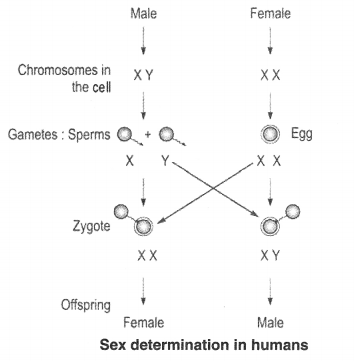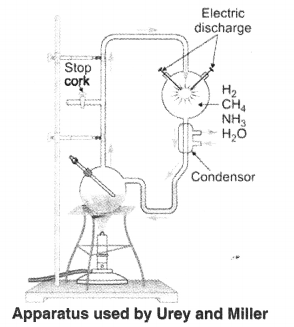In this post we are going to share the detailed solution for class 10th science chapter 9. All the solutions are prepared by our esteemed teachers who are very well experienced in the teaching.
-
Complete Science Solutions Chapter Wise : Class 10th NCERT Science Solutions – All Chapters
Chapter 9 Solutions
EXERCISE:-1
QUE:-1 If a trait A exists in 10% of a population of an asexually reproducing species and a trait B exists in 60% of the same population, which trait is likely to have arisen earlier?
ANS:-
Trait B, because it is present in more members of the population. It is likely to have arisen earlier and has now spread to 60% of the population. Trait A is new and has spread to only 10% of the population.
QUE:-2 How does the creation of variations in a species promote survival?
ANS:-
The variations provide stability to the population of various species by preventing them from getting wiped out during adverse conditions.
The natural environment also changes, and variations in species which become suited to the environment help it to survive.
EXERCISE:-2
QUE:-1 How do Mendel’s experiments show that traits may be dominant or recessive?
ANS:-
Mendel took pea plants with contrasting characteristics tall plant and dwarf (or short) plant. On cross pollination, he got all tall plants in first generation (F1). But by the self¬pollination of F1 tall plants, the plants of second generation consisted of tall and short pants in the ratio of 3 : 1. On the basis of these experiments, the characteristics appeared in first generation were called dominant (i.e. tall plants) and the characteristics that did not appear were called recessive (dwarf i.e. plants).
QUE:-2 How do Mendel’s experiments show that traits are inherited independently?
ANS:-
Mendel took two pairs of alternate expression of two traits and carried out dihybrid crosses by crossing them. The traits appeared in first generation were termed as dominant. When he used these F1 progeny to generate F2 progeny by self-pollination plants of different types were produced. In some plants both the traits were dominant, while in some plants both were recessive and some plants exhibited mixed traits. This indicates that traits are inherited independently.
QUE:-3 A man with blood group A marries a woman with blood group O and their daughter has blood group O. Is this information enough to tell you which of the traits – blood group A or O – is dominant? Why or why not?
ANS:-
This information is not enough. This is because each individual is carrying two alleles. The recessive trait can occur only when who alleles are similar. It blood group A is dominant and O is recessive, then daughter can have blood group O only when both recessive alleles occur together in mother, and father has one allele of O and other of A.
QUE:-4 How is the sex of the child determined in human beings?
ANS:-
Half of the male gametes (sperms) carry X chromosome and other half carry Y chromosomes. All the female gametes carry only X chromosomes. When a sperm fertilizes an egg, the following situations become possible.
- (i) When a sperm carrying X chromosome fertilises an egg that contains only X chromosome), the resulting zygote develops into a female (XX condition).
- (ii) When a sperm carrying Y chromosome fertilises an egg (that contains only X chromosome), the resulting zygote develops into a male (XY condition).
Thus there are 50 – 50 chances of a male or female child and none of the parents may Sex determination in humans be considered responsible for it.
The sex-determination mechanism is shown alongside.

EXERCISE:-3
QUE:-1 What are the different ways in which individuals with a particular trait may increase in a population?
ANS:-
Different ways in which individuals with a particular trait may increase in a population are as follow :
- If it gives the benefit of survival through natural selection.
- Due to a sudden increase in a particular trait in a population, i.e., by genetic drift.
QUE:-2 Why are traits acquired during the life-time of an individual not inherited?
ANS:-
The traits acquired during the life-time are changes in the non-reproductive cells of the organisms and are not capable of being passed on to the next generation.
QUE:-3 Why are the small numbers of surviving tigers a cause of worry from the point of view of genetics?
ANS:-
The small numbers of surviving tigers are a cause of worry from the point of view of genetics because in tigers there are negligible genetic variations. Due to this they are not well adapted. The rapid environmental changes cannot be favouable for them. If these changes are not controlled, tigers would be wiped out.
EXERCISE:-4
QUE:-1 What factors could lead to the rise of a new species?
ANS:-
The factors that would lead to the rise of a new species are the following :
- Geographical isolation of a population caused by various types of barriers (such as mountain ranges, rivers and sea). The geographical isolation leads to reproductive isolation due to which there is no flow of genes between separated groups of pupulation.
- Genetic drift caused by drastic changes in the frequencies of particular genes by chance alone.
- Variations caused in individuals due to a natural selection.
QUE:-2 Will geographical isolation be a major factor in the speciation of a selfpollinating plant species? Why or why not?
ANS:-
The geographical isolation cannot be major factor in the speciation of a self-pollinating plant species because it does not have to look the plants for its process of reproduction to be carried out.
QUE:-3 Will geographical isolation be a major factor in the speciation of an organism that reproduces asexually? Why or why not?
ANS:-
Geographical isolation cannot be a major factor in the speciation of an asexually reproducing organism because it does not require any other organism to carry out reproduction.
EXERCISE:-5
QUE:-1Give an example of characteristics being used to determine how close two species are in evolutionar terms.
ANS:-
If similar characteristics are shown in different organisms, then these are considered to be inherited from the common ancestry. It also shows the closeness of the species.
For example, bats and birds have some similarity in their wings, so they are closely related, while lizard and squirrel do not have wings so these are not closely related to the birds and bats.
QUE:-2 Can the wing of a butterfly and the wing of a bat be considered homologous organs? Why or why not?
ANS:-
The wings of a butterfly and the wings of a bat cannot be considered to be homologous organs because they have different basic designs though they are used for the same purpose of flying. They are analogous organs.
QUE:-3 What are fossils? What do they tell us about the process of evolution?
ANS:-
Fossils : Fossils are the remains or traces of a dead organism. These are formed through the formation of sedimentary rocks. They provide following information on the process of evolution.
- They tell about the changes that occured on the earth’s surface and the corresponding organisms.
- They tell about the gradual development of complex structured organisms from simple structured organisms.
- It is known through them that birds are evolved from reptiles.
- They state that angiosperms are developed from pteriodophytes and gymnosperms.
- They exhibit the process of humana evolution.
EXERCISE:-5
QUE:-1 Why are human beings who look so different from each other in terms of size, colour and looks said to belong to the same species?
ANS:-
This is because although genetic make up of humans may be slightly different in different races of people, there is no reproductive isolation. Reproductive isolation differentiates one species from the other. Human beings different in size, colour and looks can marry among themselves and produce fertile offspring.
QUE:-2 In evolutionary terms, can we say which among bacteria, spiders, fish and chimpanzees have a ‘better’ body design? Why or why not?
ANS:-
Bacteria is a primitive organism as they came into being very early in evolution. But these organisms are still surviving in the present conditions after millions of years. This is because they have adapted well to the changing environment over these years. Same is the case for all other organisms like spiders, fishes and chimpanzees which have adapted to their environment and have survived. Therefore, all the organisms which exist have a body design which is better as it is suited to their environment.
EXERCISE:-6 (CHAPTER END QUESTION)
QUE:-1 A Mendelian experiment consisted of breeding tall pea plants bearing violet flowers with short pea plants bearing white flowers. The progeny all bore violet flowers, but almost half of them were short. This suggests that the genetic make-up of the tall parent can be depicted as
(a) TTWW
(b) TTww
(c) TtWW
(d) TtWw
ANS:-
(c) TtWW
QUE:-2 An example of homologous organs is
(a) our arm and a dog’s fore-leg.
(b) our teeth and an elephant’s tusks.
(c) potato and runners of grass.
(d) all of the above.
ANS:-
(d) All of the above
QUE:-3 In evolutionary terms, we have more in common with
(a) a Chinese school-boy.
(b) a chimpanzee.
(c) a spider.
(d) a bacterium.
ANS:-
(a) A Chinese school-boy
QUE:-4 A study found that children with light-coloured eyes are likely to have parents with light-coloured eyes. On this basis, can we say anything about whether the light eye colour trait is dominant or recessive? Why or why not?
ANS:-
This information is not complete. On the basis of this, it cannot be decided light colour trait is dominant or recessive. So it cannot be said until one does not know the nature of this trait in the parents.
QUE:-5 How are the areas of study – evolution and classification – interlinked?
ANS:-
Classification of organisms is based on relative similarities and differences among organisms. Resemblances in organisms are because they have arisen from a common ancestor and differences in them are due to adaptations to different types of environment. Since the organisms can be graded in order of increasing complexity it indicates at the concept of evolution.
QUE:-6 Explain the terms analogous and homologous organs with examples.
ANS:-
Analogous organs : Those organs which have different basic structure (or different basic design) but have similar appearance and perform similar functions are called analogous organs.
For example, The wings of an insect and a bird are analogous organs.
Homologous organs : Those organs which have the same basic structure (or same basic design) but different functions are called homologous organs.
For example, The wing of a bat, flipper of a seal, front leg of a horse and arm of a man are homologous organs.
QUE:-7 Outline a project which aims to find the dominant coat colour in dogs.
ANS:-
Suppose a black homozygous male is mated with a white homozygous female. If the progeny has all black dogs then the dominant coat colour is black.
QUE:-8 Explain the importance of fossils in deciding evolutionary relationships.
ANS:-
Fossils play important role in providing evolutionary evidences because by knowning the age of fossils we can know about the evolution process of an organism.
For example, a fossil bird called archaeopteryx that looked like a bird had many other features of reptiles. It had feathered wings like those of birds, but teeth and tail like those of reptiles. Archaeopteryx is, therefore, a connecting link between the reptiles and birds, and hence suggests that the birds have evolved from the reptiles.
QUE:-9 What evidence do we have for the origin of life from inanimate matter?
ANS:-
A British scientist J.B.S. Haldane at first in 1929 suggested that life is originated from inanimate matter. According to him life must have developed from the simple inorganic molecules which were present at that time. Later, Miller and Urey in 1953 presented its evidences. They assembled an apparatus to create an early earth atmosphere which was supposed to consist of gases like methane, ammonia and hydrogen sulphide, etc. over water. This was maintained at a temperature just below 100°C and electric sparks were then passed through the mixture of gases to stimulate lightning for about one week. At the end of one week, it was found that about 15 per cent of carbon (from methane) had been converted into simple compounds and amino acids which make up protein molecules formed in living organisms. This experiment provides the evidence that the life originated from inanimate matter (or lifeless matter) like inorganic molecules.

QUE:-10 Explain how sexual reproduction gives rise to more viable variations than asexual reproduction. How does this affect the evolution of those organisms that reproduce sexually?
ANS:-
During sexual reproduction there is ‘crossing over’ of chromosomes, that gives rise to variations. These variations are inherited and increase the chances of survival of an organism.
- In sexual reproduction variations may occur due to errors in DNA copying.
- There may be variations due to interchange of homologous chromosomes during crossing over of male and female.
- In sexual reproduction, it is not predetermined that which gamete would fuse with another gamete. It depends only on chance. It is also a reason of variation.
These variations enable the organisms to adapt themselves to the changing conditions and also help to give rise to new species.
QUE:-11 How is the equal genetic contribution of male and female parents ensured in the progeny?
ANS:-
Genetic material in most organisms is present in pairs of chromosomes. Gametes in the sexually reproducing organisms are formed by the process of meiosis during which half of the genetic material goes into each gamete. When the gametes from male and female parents fuse with each other during sexual reproduction, the normal complement is restored. Half of the genetic material comes from the female and half from the male.
QUE:-12 Only variations that confer an advantage to an individual organism will survive in a population. Do you agree with this statement? Why or why not?
ANS:-
Yes, variations that confer an advantage to an individual organism are inherited. The organism can survive longer in an environment and maintain its existence in the population.
SUMMARY OF THE CHAPTER
* Variations arising during the process of reproduction can be inherited.
* These variations may lead to increased survival of the individuals.
* Sexually reproducing individuals have two copies of genes for the same trait. If the copies are not identical, the trait that gets expressed is called the dominant trait and the other is called the recessive trait.
* Traits in one individual may be inherited separately, giving rise to new combinations of traits in the offspring of sexual reproduction.
* Sex is determined by different factors in various species. In human beings, the sex of the child depends on whether the paternal chromosome is X (for girls) or Y (for boys).
* Variations in the species may confer survival advantages or merely contribute to the genetic drift.
* Changes in the non-reproductive tissues caused by environmental factors are not inheritable.
* Speciation may take place when variation is combined with geographical isolation.
* Evolutionary relationships are traced in the classification of organisms.
* Tracing common ancestors back in time leads us to the idea that at some point of
time, non-living material must have given rise to life.
*Evolution can be worked out by the study of not just living species, but also fossils.
* Complex organs may have evolved because of the survival advantage of even the intermediate stages.
* Organs or features may be adapted to new functions during the course of evolution. For example, feathers are thought to have been initially evolved for warmth and later adapted for flight.
* Evolution cannot be said to ‘progress’ from ‘lower’ forms to ‘higher’ forms. Rather, evolution seems to have given rise to more complex body designs even while the simpler body designs continue to flourish.
*Study of the evolution of human beings indicates that all of us belong to a single species that evolved in Africa and spread across the world in stages.
You can see other posts here:
- NCERT Class 10th Science Chapter 1 – Chemical Reactions and Equations Solutions
- NCERT Class 10th Science Chapter 2- Acids, Bases and Salts Solutions
- NCERT Class 10th Science Chapter – 3 Metals and Non Metals
- NCERT Class 10th Science Chapter – 4 Carbon and its Compounds
- NCERT Class 10th Science Chapter – 5 Periodic Classification of Elements
-
Complete Science Solutions Chapter Wise : Class 10th NCERT Science Solutions – All Chapters
Tags : Science class 10th solution, NCERT solution for class 10th science, Solution for class 10 science, 10th class science solution, Science solution 10th class, Class 10th chapter 9 science solution, Science class 10th chapter 9 solution, NCERT science class 10 solution, Class 10th solution, Solution for class 10th chapter 9 .
